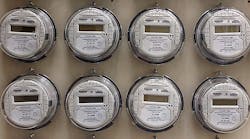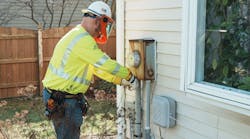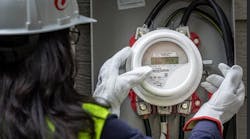The journey of Runestone Electric Association (REA) into the world of advanced metering infrastructure (AMI) started in late 2013. The utility already had an automated system for reading meters in place. The system was state of the art in the late 1990s. State of the art back then took 27 hours to receive a single read from a single meter. Additionally, a lot of time was spent dealing with meters that had stopped reading, and finding parts for the equipment was becoming a challenge. The existing technology provider announced the end of support in March 2014. Another system was needed.
System Options
Based in Alexandria, Minnesota, U.S., REA has 18,000 meters installed across 2900 miles (4667 km) of line, which is an average of four meters per mile of line. Most of the REA member base is made up of agriculture, residential and seasonal accounts, as well as a few large commercial and industrial accounts.
While searching for a replacement metering system, REA found a lot of advancements had been made to radio-frequency (RF) equipment, power-line-carrier (PLC) equipment, headend software and meters. Any data captured could be extracted and stored. And almost all the solutions offered similar data sets. Integration with customer information system (CIS) and outage management system (OMS) software also was similar in all the metering systems the utility evaluated.
The utility learned RF systems now come in multiple flavors: standard RF, mesh RF and cellular. Standard RF is like a home or business Wi-Fi network. There are access points placed throughout the system, and a meter acts as a client and communicates back to the headend software. Mesh RF is similar, but the meter acts as both client and access point. If a meter cannot find an access point but, instead, can find another meter, it can still transmit its information back to the headend software. There also are cellular modules that enable the utility to partner with a cellular provider. The cell provider provides the backbone network. This is an attractive option for areas with good cell coverage.
Significant technological strides also have been made with PLC systems. A utility no longer must wait 27 hours to get a read. The systems also now provide two-way communication that enables meters to be interrogated. PLC meters communicate through a variety of methods using voltage and current waveforms. Equipment is installed at the substation and communicates with the headend software.
Many features have been added to headend software now, as well. Headend software acts as the brains of the operation. It controls when reads occur and is the focal point for integration with other systems such as CIS, OMS and others. Some headend software also includes tools for mining and reporting data. A couple of the systems also offer a meter data management (MDM) system to fill in holes for missing data. Most of the systems are web based, which means there is no software to install.
Electronic meters are the norm today, so good-bye to mechanical meters. When it comes to modules, there are two kinds: a stand-alone module that plugs into the meter or an integrated module on the meter itself. REA evaluated the modules closely when examining various AMI systems. Some AMI vendors only work with certain meters.
Factors Affecting the Decision
The day came when a decision had to be made. A lot of factors came into play. As cooperatives are owned and governed by members, REA looked at how its members would benefit from a new metering system. The search was narrowed down to two products: a PLC system and a RF system. First, cost was a factor in deciding which system would fit. The expected recurring cost of each system was analyzed.
Because REA has a rural system spread across 2900 miles of line, a RF system would provide some challenges. Multiple tower sites would be needed and, in some cases, access points would be required to serve a single member. Another issue was the cost volatility of towers and U.S. Federal Communications Commission leases. Adding another layer of infrastructure and investment over what was represented in the existing distribution grid was not cost effective, because the additional layer would need to be managed and maintained.
A PLC system uses the existing infrastructure, a distribution grid that represents an investment of millions of dollars. And because a PLC was currently in place, it was familiar to REA staff. Some work would have to be done at a few substations to put an updated PLC system in place, but it would be done by resources who were familiar with the technology.
In the end, REA selected Aclara’s TWACS product. This PLC system provides on-demand readings, remote-disconnect capability and interval data, and it integrates with the existing CIS and OMS software. Aclara also has other products in the cellular and RF space REA could migrate to in the future, if that route became attractive for the utility. The TWACS technology is mature, the hardware is reliable and the system provides real-time communication. Additionally, REA also could choose what meters to use with the system.
Because REA had experience with Landis+Gyr meters in the past, and had local resources and support for them, the utility chose Landis+Gyr Focus meters. Aclara also had experience working with Landis+Gyr, so the integration of its modules into the meters was seamless.
System Deployment
The next phase was to plan the deployment of the system. The project was scheduled over the course of three years, with meter and equipment orders spaced out over those three years. This was helpful not only financially but also for workload. All who worked on the project had other duties. Spreading out the project over three years provided some much-needed breathing room. The old PLC system had to be kept running during this time. REA also decided to use internal resources to change out meters. This works well because these are the folks who know the system best. They know where every meter is and which services needed to be rebuilt.
One of the key objectives of the project was to settle on standard meter forms. Over the years, a variety of meter forms had been installed. These odd meter forms were rebuilt to fit one of the standard forms.
The other objective was to standardize on register ratios, also known as dial multipliers. A lot of off-peak services run through a current transformer, which required the meter’s register to be set to record. Thus, field staff had to carry a variety of meters to handle this. Billing software was implemented to handle these multipliers. The hope is this will make life easier for folks in the field. REA also spaced out the new meter numbers from the old to make it easier for everyone to know if a new or old meter was installed.
Lastly, a meter change-out procedure was specified. Partners at STAR Energy Services were engaged to build an Esri Collector app. This app enables REA’s resources to take a picture of an old meter, record the final reading, enter the new meter and take a picture of the new meter. All this data was a layer on the existing map. The change-out data was downloaded daily and processed into the billing system.
The first year purposefully was taken at a slow pace. Employees were sent to training to learn about the substation equipment and headend software. The first substation converted over to TWACS was close to the main office. This enabled staff to test the system with meters near the office. It did not take long to realize the system worked as advertised.
It is now midway through year two and REA has learned a lot. The utility found a few old meters in which the register reading and module reading were different. Some old meters were too slow or too fast. This, of course, affects line losses. The average line loss at the beginning of the project was 6.6%; today, it is 5.3% and falling.
REA also can pull data from the system and provide it to engineers for back-feed analysis. The utility did come across some challenges, as well. Some off-peak installations use a peak interrupter panel. The utility found when the TWACS meter was wired through this panel and interrogation was attempted, the fuse in the panel would be blown and require a trip by the load management technician. Findings like this were embraced as learning opportunities.
About 6500 meters are left to be replaced. REA plans to complete the project by August or September 2017.
Scott Krueger is the billing and information technology supervisor for Runestone Electric Association. He has more than 20 years of professional IT experience working in the manufacturing, financial, distribution, telecommunications and utility industries.






